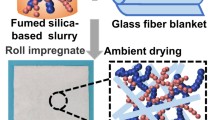Abstract
In this study, the formation of silica–chitosan hybrid materials via sol–gel process under pH values of 2–6 were investigated using N2 sorption analysis, scanning electron microscopy, transmission electron microscopy, thermal analysis and zeta potential analyzer. The hierarchical structure consisting of meso- and macropore was formed when pH value was higher than 2. Mesopores were formed as the interparticle channels of silica nanoparticles aggregates, whereas macropores were the void between the aggregates (clusters). The clusters size was decreased with increasing the pH value, resulting in the increase of the macroporosity. The thermal conductivity of the products was controlled in the range of 0.06 and 0.13 W m−1 K−1 by varying the product porosity between 88 and 69% (pH 6 and pH 2, respectively).




Similar content being viewed by others
References
Alesi S, Di Maria F, Melucci M, Macquarrie DJ, Luque R, Barbarella G (2008) Green Chem 10:517. doi:10.1039/b718776a
Hun X, Zhang Z (2008) Sens Actuators B Chem 131:403. doi:10.1016/j.snb.2007.11.055
Zhang R, Yang C (2008) J Mater Chem 18:2691. doi:10.1039/b800025e
Yeh J-T, Chen C-L, Huang K-S (2007) Mater Lett 61:1292. doi:10.1016/j.matlet.2006.07.016
Pedroni V, Schulz PC, Gschaider de Ferreira ME, Morini MA (2000) Colloid Polym Sci 278:964. doi:10.1007/s003960000348
Witoon T, Chareonpanich M, Limtrakul J (2008) Mater Lett 62:1476. doi:10.1016/j.matlet.2007.09.004
Rashidova SSh, Shakarova DSh, Ruzimuradov ON, Satubaldieva DT, Zalyalieva SV, Shpigun OA, Varlamov VP, Kabulov BD (2004) J Chromatogr B 800:49. doi:10.1016/j.jchromb.2003.10.015
Suzuki T, Mizushima Y, Umeda T, Ohashi R (1999) J Biosci Bioeng 88:194. doi:10.1016/S1389-1723(99)80201-1
Ayers MR, Hunt AJ (2001) J Non-Cryst Solids 285:123. doi:10.1016/S0022-3093(01)00442-2
Hu X, Littrel K, Ji S, Pickles DG, Risen WM Jr (2001) J Non-Cryst Solids 288:184. doi:10.1016/S0022-3093(01)00625-1
Retuert J, Quijada R, Arias V (2003) J Mater Res 18:487. doi:10.1557/JMR.2003.0062
Brinker CJ, Scherer GW (1990) Sol–gel science. Academic Press, New York
Hench LL, West JK (1990) Chem Rev 90:33. doi:10.1021/cr00099a003
Patwardhan SV, Clarson SJ (2003) Mater Sci Eng C 23:495
Bandyopadhyay A, Sarkar MD, Bhowmick AK (2006) J Mater Sci 41:5981. doi:10.1007/s10853-006-0254-x
Ogoshi T, Chujo Y (2005) J Mater Chem 15:315. doi:10.1039/b411448e
Kresge CT, Leonowicz ME, Roth WJ, Vartuli JC, Beck JS (1992) Nature 359:710. doi:10.1038/359710a0
Takahashi R, Sato S, Sodesawa T, Tomita Y (2005) J Ceram Soc Jpn 113:92. doi:10.2109/jcersj.113.92
Colombo P (2008) J Eur Ceram Soc 28:1389. doi:10.1016/j.jeurceramsoc.2007.12.002
Gonçalves MRF, Bergmann CP (2007) Constr Build Mater 21:2059. doi:10.1016/j.conbuildmat.2006.05.057
Chareonpanich M, Namto T, Kongkachuichay P, Limtrakul J (2004) Fuel Process Technol 85:1623. doi:10.1016/j.fuproc.2003.10.026
Odlyha M, Scott RPW, Simpson CF (1993) J Therm Anal 40:1197. doi:10.1007/BF02546883
Iler RK (1979) The chemistry of silica. Wiley, New York
Anal AK, Tobiassen A, Flanagan J, Singh H (2008) Colloids surf B 64:104
Acknowledgments
This work was financially supported by the Thailand Research Fund through the Royal Golden Jubilee PhD Program (Grant No. PHD/0012/2548), the National Nanotechnology Center through its National Nanoscience Consortium, the Kasetsart University Research and Development Institute, and Center of Excellence for Petroleum, Petrochemicals and Advanced Materials (PARDO).
Author information
Authors and Affiliations
Corresponding author
Rights and permissions
About this article
Cite this article
Witoon, T., Chareonpanich, M. & Limtrakul, J. Effect of acidity on the formation of silica–chitosan hybrid materials and thermal conductive property. J Sol-Gel Sci Technol 51, 146–152 (2009). https://doi.org/10.1007/s10971-009-1986-2
Received:
Accepted:
Published:
Issue Date:
DOI: https://doi.org/10.1007/s10971-009-1986-2




